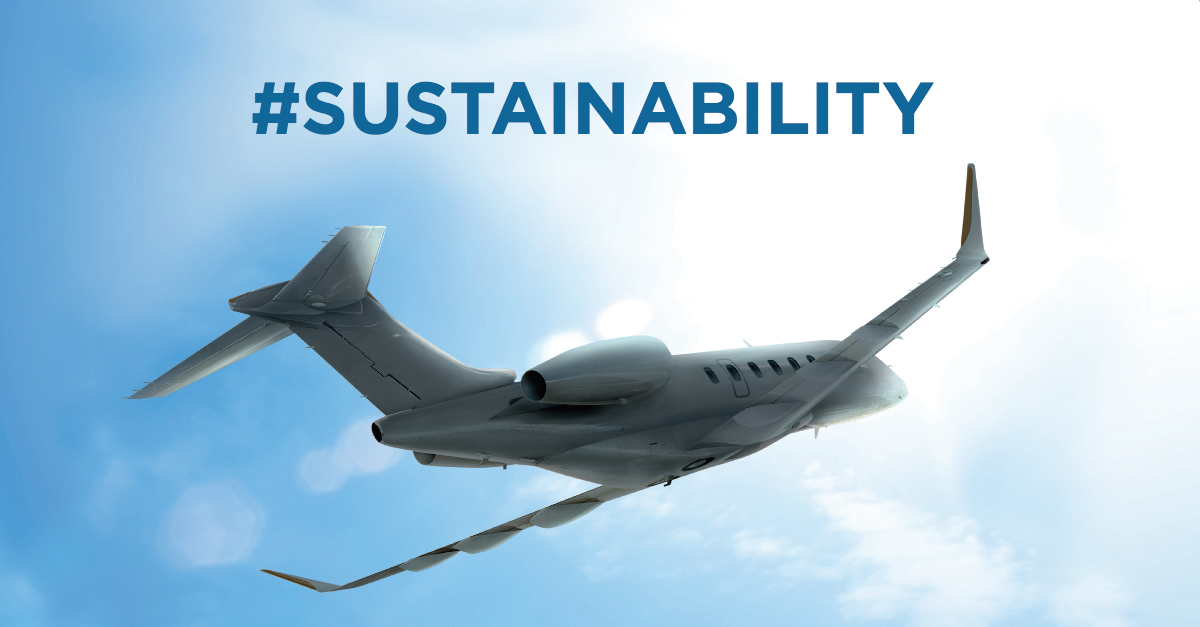
July 9, 2018

Make no mistake: jet fuels derived from renewable energy sources aren’t a far-off dream. Multiple technology paths exist to produce such fuels, and innumerable test flights over the past decade have consistently demonstrated their equal performance to conventional Jet A.
One of the strongest industry proponents has been Gulfstream Aerospace, which uses a 30/70 blend of low-carbon, drop-in renewable fuel and Jet A to power its fleet of customer support aircraft, as well as company flights. The manufacturer even used this fuel while testing its G500 and G600 business jets.
“We’ve flown over half a million nautical miles on renewable fuels, saving over one million pounds of CO2 emissions,” noted Charles Etter, environmental and regulatory affairs tech fellow at Gulfstream. “We’re very proud of that as a company.”
However, a lack of widescale production facilities and distribution outlets, and resultant higher consumer prices (versus petroleum-derived jet fuel) have hindered broader adoption of sustainable alternative jet fuel (SAJF). Etter noted that Gulfstream frequently engages with its customers on the potential benefits of flying with sustainable fuels, “but the cost is a hindering factor.”
GREATER AVAILABILITY
Even as SAJF acceptance has lagged in the market, there has been extensive work behind the scenes to improve the availability of these fuels. At the 2018 European Business Aviation Convention & Exhibition (EBACE2018) in May, NBAA joined with other industry stakeholders to announce The Business Aviation Guide to Sustainable Alternative Jet Fuels, which is focused on raising awareness and adoption of available and emerging alternative jet fuel options in the U.S. and Europe.
“The technology is there, but the limiting factor has primarily been the lack of production facilities and widespread distribution sources,” said Eli Cotti, NBAA’s director of technical operations. “Through this new initiative we hope that business aviation may advance the proliferation of alternative fuels at all the logical touchpoints: the manufacturers, the ground handlers and the operators, at the national, regional and international levels.”
Also working toward these goals is the Commercial Aviation Alternative Fuels Initiative (CAAFI), a public/private partnership between the aviation com-munity and the FAA that is focusing on accelerating development and deployment of sustainable alternatives to Jet A. This includes collaboration with other industry stakeholders via dedicated initiatives like the Farm-to-Fly 2.0 program, which involves NBAA and multiple government agencies.
AVGAS ALTERNATIVES GAIN GROUND
Operators of piston-engine aircraft may also soon find alternatives to 100LL avgas at air-ports across the country as several companies work to develop a true drop-in replacement for 100LL through the joint industry/regulatory Piston Aviation Fuels Initiative (PAFI). While that product remains in the future, some fixed-based operators are looking to alternatives. Dan DeMeo, operator of Rabbit Aviation at San Carlos Airport (SQL) in California’s Silicon Valley, first explored the possibility of an avgas alternative in the aftermath of the Great Recession.
“I wanted an exclusive product to offer, and I looked to unleaded, no-ethanol automotive gasoline as that’s what I’d flown with while training for my private pilot license,” he explained. “As it turned out, I’d never had such good timing in my life, as soon after SQL became one of the 17 airports chosen by the FAA for monitoring lead emissions.”

DeMeo found support from the airport authority and county officials, as well as significant customer interest. “We have rows and rows of Cessna 172SPs here, and almost everyone renting them has said, ‘We want unleaded fuel,’” he continued. “Flight schools discovered their members would rather fly with unleaded fuel due to environmental concerns.”
In 2016, Rabbit Aviation became one of a select number of authorized distributors for 94 octane unleaded fuel (UL94) produced by Swift Fuels. While not a true drop-in replacement for 100LL, UL94 is approved for use in a variety of non-turbocharged piston aircraft engines with compression ratios of 8.5:1 or lower through supplemental type certification approval.
“That’s basically just paperwork, and aircraft already certified to use 80 octane fuels don’t even require that,” DeMeo explained. “There are no mechanical changes, and Swift Fuels’ UL94 is almost identical to 100LL avgas in weight and energy. Costs are competitive as well.
“In fact, some may be surprised to find that rack costs for UL94 are often cheaper than for a comparable batch of 100LL,” he continued. “Adding lead is very expensive, although distribution costs offset that advantage, as 100LL benefits from an established distribution network.”
DeMeo recently secured a lease for a new, larger storage tank for unleaded fuel, with construction planned this summer. “Lowering a product’s cost is a surefire way to incentivize its use,” he stated. “It would be great to be able to buy an entire rail tanker of fuel to drive prices way down.”
We’ve flown over half a million nautical miles on renewable fuels, saving over one million pounds of CO2 emissions. We’re very proud of that as a company.
CAAFI Assistant Director Chris Tindal admitted that some market reticence exists against greater use of sustainable fuels, requiring a concerted effort to educate the aviation community and general public.
“When people hear the term ‘biofuels,’ their minds go to ethanol or biodiesel, which have some product deficiencies, without a full grasp of what we’re trying to do,” Tindal explained. “We’re taking a different approach by producing synthetic jet fuel, which has the same or better attributes versus kerosene-based jet fuel. We aren’t trying to take over the oil market or put refineries out of business; we want to supplement them and provide better energy, security and supply for the industry, while making jet fuel more sustainable.”
In 2016, AltAir Fuels earned certification from the Roundtable on Sustainable Biomaterials (RSB) to become the first U.S. source for continuous production of renewable diesel and jet fuel at a con-verted oil refinery in Paramount, CA. The company subsequently received RSB sustainability certification for its jet fuel in 2018.
“Some entities in this space have also announced plans to expand production, and new players continue to come onboard, including petroleum refiners,” noted CAAFI Executive Director Steve Csonka. “The aviation industry continues to expand the definition of conversion processes that can be used to produce SAJF. We continue to pursue approaches that will lower production costs and take advantage of various sustainable feed-stock solutions available on a worldwide basis.”

Often, these facilities also supply diesel fuel with which SAJF competes for production capacity. “To a fairly large degree, these facilities tune their output to various proportions [of both fuels],” Csonka said. “In some cases, diesel is more profitable, especially with existing policy support mechanisms, but as we’re now seeing, the industry is continually progressing to increase the availability of sustainable Jet A.
“After all, SAJF is still jet fuel,” he concluded. “It’s approved for use in your equipment, and there is nothing to prevent you from using it, provided you can contract its supply.”
Learn more about alternative fuels at www.nbaa.org/environment and get The Sustainable Alternative Jet Fuel Business Aviation Guide at www.futureofsustainablefuel.com.
METHODS TO GENERATE SUSTAINABLE ALTERNATIVE JET FUELS
To date, alternative jet-fuel blending agents for commercial flights have been derived from biological sources using one of the following approved processes:
- Fischer-Tropsch conversion of gases synthesized from biogas or biomass from municipal solid waste, landfill gas or forestry residues, also called FT-SPK (both with and without some aromatic content).
- Hydroprocessed esters and fatty acids (conversion from plant and animal oils), otherwise known as HEFA-SPK.
- Microbial conversion of sugars derived directly from plants or through hydrolyzation (the use of water to break apart chemical bonds) also known as HFS-SIP.
- The conversion of alcohols to jet fuel, known as ATJ-SPK, currently approved for use of ethanol and iso-butanol, which themselves may be derived from multiple sources.
Fuel molecules from those processes are required to be blended with varying proportions of petroleum-derived Jet A, including a 50-percent maximum blend for FT-SPK, HEFA-SPK and ATJ-SPK, and 10 percent max for HFS-SIP.
These processes and requisite fuel properties are outlined by ASTM Specification D7566. When these components are blended with petroleum jet fuel at allowable levels, they can then be re-categorized as D1655 fuels, the standard for aviation turbine fuels, and are indistinguishable from petroleum-based Jet A.
VIEW THIS ARTICLE IN THE APP
This article originally appeared in the July/August 2018 issue of Business Aviation Insider. Download the magazine app for iOS and Android tablets and smartphones.


 International Business Aviation Council Ltd.
International Business Aviation Council Ltd.